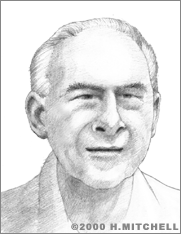Albert Macovski
Professor Albert Macovski has been called "the most inventive person" at Stanford University. Macovski has won this high praise by establishing himself, with over 150 patents in the last 50 years, as the nation's foremost authority on computerized imaging systems, especially those used in medicine.
Macovski earned a BEE from City College of New York in 1950 and an MEE from the Brooklyn Polytechnic Institute in 1953. From 1950 to 1957, he was also on the technical staff at RCA Laboratories, where his improvements in TV receiver circuitry earned him his first patents and many awards. In 1957, Macovski returned to Brooklyn Polytech as an assistant professor and later an associate professor.
In 1960, Macovski left the east coast for Stanford University, working as a staff scientist at the Stanford Research Institute (SRI) while earning a PhD in Electrical Engineering (1968). At SRI, Macovski continued his work in television technology. His most significant patents from this period were for the single-tube color camera, which was soon adopted for all camcorders, and the basics of TV interferometry (the subject of Macovski's doctoral thesis). Other patents covered improvements to printing, fax, holographic, and encoded-color systems.
In 1972, Macovski accepted a joint appointment in Stanford's Electrical Engineering and Radiology departments. Here, he began to work on the whole spectrum of medical imaging systems, including digital radiography (x-ray), ultrasound, computerized axial tomography (CAT), and magnetic resonance imaging (MRI). Macovski's refinements gave these systems unprecedented subtlety and reliability. For example, his invention of real-time phased-array imaging for ultrasound first enabled doctors to observe not just the outlines of organs, but also the functioning of the organs, even in a very young fetus. Often Macovski would target and correct a specific shortcoming in the technology. His improvements to x-ray and CAT scans first allowed for effective analysis of lesions and certain metabolites. He enabled MRI machines to image the flow of blood based on its motion alone, rendering injections of foreign "contrast material" unnecessary.
Partly because Macovski's work often depends on radical rethinking of how imaging systems acquire and process data, his inventions tend to drastically reduce the costs of what are, as a rule, very expensive diagnostic services. A career that began with improving consumer goods turned into a history of contributions to health and the quality of life.
Albert Macovski continues his work at Stanford as the Canon USA Professor of Engineering Emeritus, where he is also renowned as a mentor to an entire generation of imaging engineers. In addition to earning over 150 patents, Macovski has written over 200 technical articles and the textbook "Medical Imaging Systems." He is a Founding Fellow of the American Institute of Medical and Biological Engineering and has won numerous awards, including the Zworykin Award (1973) and the Peninsula Patent Attorney Association of Northern California's Inventor of the Year Award (1988).


